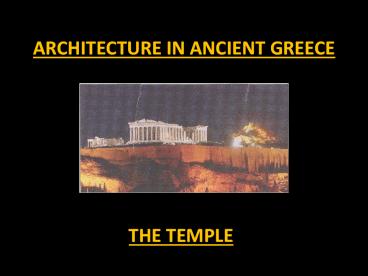ARCHITECTURE IN ANCIENT GREECE - PowerPoint PPT Presentation
1 / 16
Title:
ARCHITECTURE IN ANCIENT GREECE
Description:
The Hephastion, Athens stylobate peristyle naos Greek Temples were constructed by a relatively simple post-and-lintel principle. Vertical posts ... – PowerPoint PPT presentation
Number of Views:143
Avg rating:3.0/5.0
Title: ARCHITECTURE IN ANCIENT GREECE
1
ARCHITECTURE IN ANCIENT GREECE
THE TEMPLE
2
Why Temples?
- The Temple is arguably the most characteristic
and recognisable of all Greek buildings. - To perform the rituals of worship, nothing more
than an open air altar was necessary. - So, Why temples?
- When the Greeks began to build statues for their
deities it followed that they needed to build a
shelter to protect them. - Temples were not constructed to house a
congregation.
3
A Simple Temple Plan
- Temples were constructed in brick, wood or
undressed stone. - The statue of the deity was housed in the naos.
- The porch of the temple was called the pronaos.
- The foundation was usually stone.
naos
pronaos
4
The simple plan evolving...
- A porch at the rear of the temple was added for
symmetrical reasons. - This was called the opisthodomos
- It was not possible to enter the temple from the
opisthodomos.
opisthodomos
naos
pronaos
5
The larger temples
peristyle
- Larger temples were built to stand free in a
clear space. - Therefore the temple would be visible from many
points of view. - They surrounded the naos with a colonnade of
columns, called a peristyle
pronaos
naos
opisthodomos
6
The Greeks varied and modified their temples
based on these four basic floor plans The
simple temple consisting of just naos and
pronaos The evolution of the simple temple,
containing the addition of a back porch purely
for symmetry called the opisthodomos The
peristyle temple with an impressive appearance
from every angle due to the colonnade of columns
7
- This is the ostentatious double peristyle or
dipteral plan, with two colonnades of columns. - Only the wealthier poleis could build the
imposing dipteral temples. These structures
would have been huge and very costly.
8
The Parthenon floor plan
- The Parthenon is classed as a Doric order temple,
although the floor plan is slightly embellished
compared to the standard single peristyle floor
plan.
9
- The temple was generally built on a platform
consisting of three steps. - The top step was called the stylobate, and on it
stood the columns of the peristyle and the naos. - A temple would be carefully positioned within a
sanctuary - The goal was to ensure that it was possible to
tell at first glance that the temple was 3
dimensional. - The positioning also aimed to ensure that the
principle dimensions of the temple (length, width
and height) could all be taken in at the first
glance.
10
The Hephastion, Athens
naos
stylobate
peristyle
11
- Greek Temples were constructed by a relatively
simple post-and-lintel principle. - Vertical posts (either columns or walls)
supported horizontal lintels (entablatures or
ceilings.) - By the end of the 7th century BCE stone became
the preferred material. - Today, the only temples with substantial remains
were constructed of stone. - The two main types of stone used were coarse
limestone and marble.
12
- It was not until the final stages of building
that the columns were fluted - meaning vertical
channels were carved into the shafts. - The columns and the entablature were designed so
that they belonged to one of two orders - the
Doric order, or the Ionic order. - In each order the proportion of the elements and
the scheme in which they were decorated were all
coordinated with each other.
13
The Doric Order
Triglyph and metope
Capital and abecus
Architrave and frieze
Column shafts
The Doric order was characterized by being
strong, simple and massive.
14
The Ionic Order
Cornice
Frieze
Abecus and architrave
Volute capitals
The Ionic order is characteristically delicate
and ornate
Column shafts
Column bases
15
- Despite minor derivations, each order always
preserved its own special character. - At the end of the 5th Century BCE the Corinthian
capital was invented. It was very popular and
was as an alternative to the Ionic capital.
DORIC
IONIC
CORINTHIAN
16
Elements and Principles of design AESTHETIC
QUALITIES

